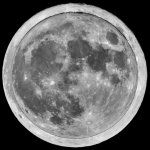June 9th: Night of the “Micromoon”
 The “supermoon” — a full moon that occurs when the moon is nearest the earth — seems to garner a lot of media attention. Very little scrutiny is paid to the occurrences of “micromoon” — an appellation bestowed when the full moon occurs at the furthest reaches of its orbit. Just Google “supermoon” and you’ll get 10-million results vs. a paltry 45,000 for “micromoon”. But the micromoon offers an interesting contrast to the supermoon.
The “supermoon” — a full moon that occurs when the moon is nearest the earth — seems to garner a lot of media attention. Very little scrutiny is paid to the occurrences of “micromoon” — an appellation bestowed when the full moon occurs at the furthest reaches of its orbit. Just Google “supermoon” and you’ll get 10-million results vs. a paltry 45,000 for “micromoon”. But the micromoon offers an interesting contrast to the supermoon.

If you could compare the extremes of supermoon to micromoon side-by-side in the sky, you’d find the supermoon 14% greater in diameter and 30% brighter than its smaller cousin. But a real-time, side-by-side comparison is impossible of course. If you casually pointed out a supermoon or micromoon in the sky to a friend, it may be difficult for them to discern the size and brightness differences just by naked-eye observation. But photos don’t lie.
Image Comparison
It’s a neat project to image both types of moons with the same equipment/camera settings and then combine the images. You’ll have a permanent record of how the moons varies in size and brightness to show your friends. But you’ll need to keep a record of the camera zoom and exposure settings and know the dates of the “super” and “micro” moons.
Save These Dates and Earth-Moon Distances
Your next opportunities for micromoons are this Friday, June 9, 2017 at 13:11-UT (406,268-km), followed by Friday, July 27, 2018 at 20:21-UT (406,092-km)— over a year apart.
The next supermoons are Sunday, December 3, 2017 at 15:47-UT (357,988-km) and Tuesday January 2, 2018 at 02:24-UT (356,604-km) — only a month apart.
Our FoneMate™ (mobile site) is perfect for lunar imaging. It cradles your smartphone on any DIOPTRX™-ready Tele Vue eyepiece. (Most Tele Vue eyepieces are DIOPTRX-ready — see the last column of our Eyepiece Spec chart [mobile site].) Adjust the zoom setting on your camera/video app and start imaging.


